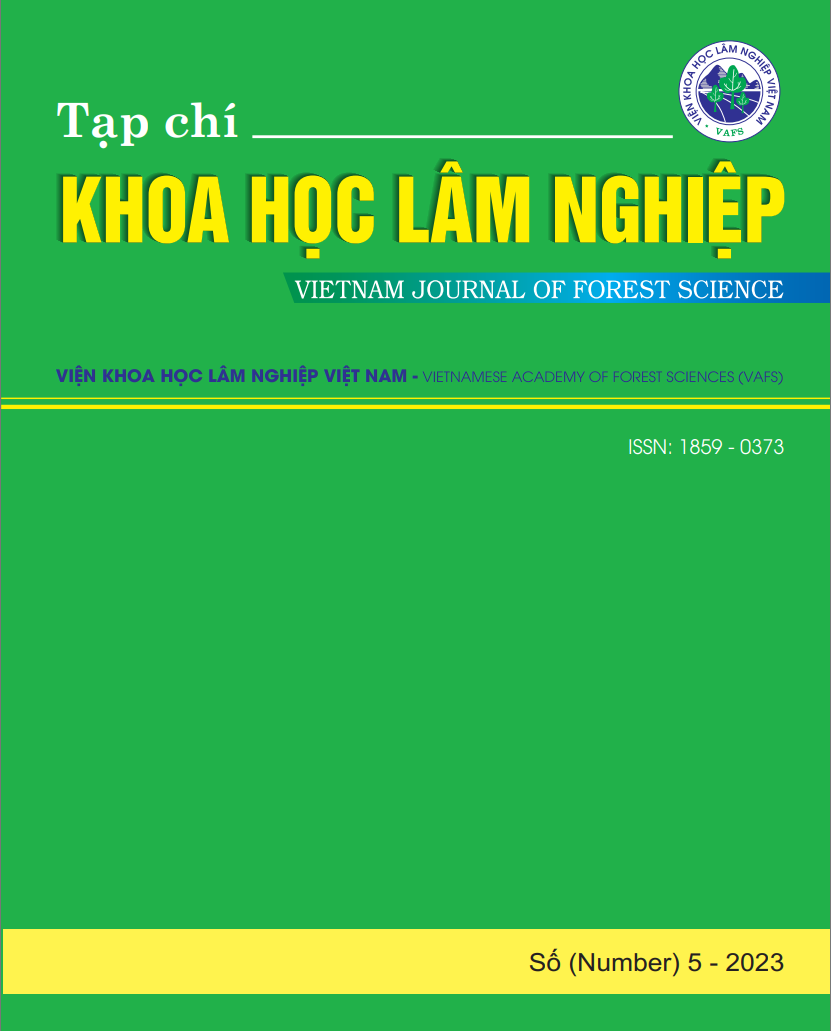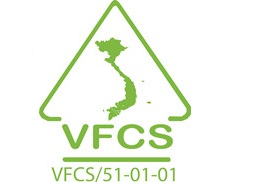Ổ SINH THÁI VÀ MỐI QUAN HỆ CỦA CÁC LOÀI CÂY TRONG RỪNG LÁ RỘNG THƯỜNG XANH Ở KHU BẢO TỒN THIÊN NHIÊN VĂN HÓA ĐỒNG NAI
Từ khóa:
Chi bình phương, lý thuyết ổ sinh thái, rừng nhiệt đới, sinh thái quần xã, tương tác loàiTóm tắt
Sự chung sống của các loài là chủ đề trọng tâm trong sinh thái học. Nghiên cứu đặc điểm ổ sinh thái và mối quan hệ của các loài cây có thể phản ánh một cách khách quan sự phân bố và mức độ thích ứng của các loài với môi trường, đồng thời tiết lộ cấu trúc của các quần thể và cơ chế duy trì tính đa dạng trong quần xã. Trong nghiên cứu này, đặc điểm ổ sinh thái và mối quan hệ của các loài cây gỗ ưu thế và đồng ưu thế trong kiểu rừng lá rộng thường xanh ở Khu bảo tồn Thiên nhiên Văn hóa Đồng Nai, tỉnh Đồng Nai đã được phân tích định lượng. Vào cuối năm 2022, một ô nghiên cứu rộng 4 ha đã được thiết lập trong phân khu bảo vệ nghiêm ngặt của Khu bảo tồn, phục vụ cho việc thu thập dữ liệu. Tất cả các cây gỗ có đường kính ngang ngực (dbh) > 5 cm được định danh và đo dbh. Kết quả cho thấy, 5 trong số 11 loài cây thuộc nhóm loài ưu thế của lâm phần là thực sự có ý nghĩa về mặt sinh thái tại thời điểm nghiên cứu. Sự tương đồng, độ rộng và mức độ chồng chéo ổ sinh thái của các loài ưu thế và đồng ưu thế chỉ ra rằng, hầu hết chúng là các loài cây chuyên biệt, có yêu cầu về môi trường sống khác nhau. Phân tích mối quan hệ tổng thể của các loài cây cho thấy, lâm phần ở trạng thái tương đối ổn định với tỷ lệ phương sai VR =1,31. Trong số 55 cặp của 11 loài cây đã được phân tích, 5 cặp loài vượt qua cả ba loại kiểm định Chi bình phương, hệ số liên kết AC và tương quan Pearson; cụ thể, 2 cặp có mối quan hệ cạnh tranh và 3 cặp có mối quan hệ tạo thuận lợi. Sự khác biệt về ổ sinh thái và mối quan hệ của các loài trong nghiên cứu này cần phải được chú ý khi lập kế hoạch quản lý rừng và phát triển các chiến lược phục hồi thảm thực vật ở khu vực nghiên cứu.
Tài liệu tham khảo
Abrams P., 1980. Some comments on measuring niche overlap. Ecology 61(1): 44 - 49.
Alley T.R., 1982. Competition theory, evolution, and the concept of an ecological niche. Acta Biotheoretica 31(3): 165-179.
BazzazF.A., 1991. Habitat selection in plants. The American Naturalist 137: 116-130.
Bertness M.D., and Callaway R.M., 1994. Positive interactions in communities. Trends Ecol. Evo. 9: 191-193.
Blanchet F.G., Cazelles K., and Gravel D., 2020. Co-occurrence is not evidence of ecological interactions. Ecology Letters 23(7): 1050-1063.
Bloom S.A., 1981. Similarity indices in community studies: potential pitfalls. Marine Ecology Progress Series 1: 125-128.
Bond W.J., and Midgley J.J., 2001. Ecology of sprouting in woody plants: the persistence niche. Trends in ecology & evolution 16(1): 45-51.
Brokaw N., and Busing R.T., 2000. Niche versus chance and tree diversity in forest gaps. Trends in ecology & evolution 15(5): 183-188.
Brooker R.W., Maestre F.T., Callaway R.M., Lortie C.L., Cavieres L.A., Kunstler G., Anthelme F., 2008. Facilitation in plant communities: the past, the present, and the future. Journal of Ecology 1: 18-34.
Brown J.H., and Lieberman G.A., 1973. Resource utilization and coexistence of seed-eating desert rodents in sand dune habitats. Ecology 54(4): 788-797.
Burdon J.J., Jarosz A.M., and Kirby G.C., 1989. Pattern and patchiness in plant-pathogen interactions-causes and consequences. Annual Review of Ecology and Systematics 20(1): 119-136.
Cazelles K., Araújo M.B., Mouquet N., and Gravel D., 2016. A theory for species co-occurrence in interaction networks. Theoretical Ecology 9: 39-48.
Chai Z., Sun C., Wang D., and Liu W., 2016. Interspecific associations of dominant tree populations in a virgin old-growth oak forest in the Qinling Mountains, China. Botanical studies 57(1): 1-13.
Chen G., Wu Z., Gu B., Liu D., Li X., and Wang Y., 2011. Isotopic niche overlap of two planktivorous fish in southern China. Limnology 12: 151-155.
Cody M.L., MacArthur R.H., and Diamond J.M., 1975. Ecology and evolution of communities: Harvard University Press.
Cole L.C., 1949. The measurement of interspecific associaton. Ecology 3: 411-424.
Eisenhauer N., Yee K., Johnson E.A., Maraun M., Parkinson D., Straube D., and Scheu S., 2011. Positive relationship between herbaceous layer diversity and the performance of soil biota in a temperate forest. Soil Biology and Biochemistry 43(2): 462-465.
Erman D.C., and Helm W.T., 1971. Comparison of some species importance values and ordination techniques used to analyse benthic invertebrate communities. Oikos 1: 240-247.
Ewel J.J., and Hiremath A.J., 2005. Plant-plant interactions in tropical forests Biotic interactions in the tropics: their role in the maintenance of et species diversity (pp. 3-34). Cambridge: Cambridge University Press.
Fehmi J.S., and Bartolome J.W., 2001. A grid-based method for sampling and analysing spatially ambiguous plants. Journal of Vegetation Science 12(4): 467-472.
Feinsinger P., Spears E.E., and Poole R.W., 1981. A simple measure of niche breadth. Ecology 62(1): 27-32.
Feroz S., Yoshimura K., and Hagihara A., 2008. Stand stratification and woody species diversity of a subtropical forest in limestone habitat in the northern part of Okinawa Island. Journal of Plant Research 121: 329-337.
Fiegna F., Moreno-Letelier A., Bell T., and Barraclough T.G., 2015. Evolution of species interactions determines microbial community productivity in new environments. The ISMEjournal 9(5): 1235-1245.
Forbes S.A., 1907. On the local distribution of certain Illinois fishes: an essay in statistical ecology (vol. 7): Illinois State Laboratory of Natural History.
Gómez-Aparicio L., 2009. The role of plant interactions in the restoration of degraded ecosystems: a meta-analysis across life-forms and ecosystems. Journal ofEcology 97(6): 1202-1214.
Gong Z.W., Kang X.G., Gu L., Gao Y., Feng Q.X., and Yao J.C., 2011. Interspecific association among arbor species in two succession stages of spruce-fir conifer and broadleaved mixed forest in Changbai Mountains, northeastern China. Journal of Beijing Forestry University 33(5): 28-33.
Grundel R., Jean R.P., Frohnapple K.J., Glowacki G.A., Scott P.E., and Pavlovic N.B., 2010. Floral and nesting resources, habitat structure, and fire influence bee distribution across an open-forest gradient. Ecological applications 20(6): 1678-1692.
Gu L., Gong Z.W., and Li W.Z., 2017. Niches and Interspecific Associations of Dominant Populations in Three Changed Stages of Natural Secondary Forests on Loess Plateau, P.R. China. Sci Rep 7: 6604.
Hallett J.G., 1982. Habitat selection and the community matrix of a desert small-mammal fauna. Ecology 63(5): 1400-1410.
Hamback P.A., and Beckerman A.P., 2003. Herbivory and plant resource competition: a review of two interacting interactions. Oikos 101(1): 26-37.
Hirzel A.H., and Le Lay G., 2008. Habitat suitability modelling and niche theory. Journal of applied ecology 45(5): 1372-1381.
Pham Hoang Ho, 1999. Plants of Vietnam. Hanoi, Vietnam: Youth Publishing House.
Holt R.D., 1987. On the relation between niche overlap and competition: the effect of incommensurable niche dimensions. Oikos 1: 110-114.
Tran Hop, 2002. Vietnam Forest Trees. Hanoi, Vietnam: Agriculture Publishing House.
Hurlbert S.H., 1969. A coefficient of interspecific assciation. Ecology 50(1): 1-9.
Janssen A., Pallini A., Venzon M., and Sabelis M.W., 1998. Review Behaviour and indirect interactions in food webs of plant-inhabiting arthropods. Experimental & Applied Acarology 22: 497-521.
Jiang H., Zhang H., Long W.X., Fang Y.S., Fu M.Q., and Zhu K.X., 2019. Interspecific associations and niche characteristics of communities invaded by Decalobanthus boisianus. Biodiversity Science 27: 388-399.
Kindt R., and Kindt M.R., 2019. Package ‘BiodiversityR’. Package for community ecology and suitability analysis 2: 11-12.
Komonen A., Grapputo A., Kaitala V., Kotiaho J.S., and Paivinen J., 2004. The role of niche breadth, resource availability and range position on the life history of butterflies. Oikos 105(no. 1): 41-54.
Levins R., 1968. Evolution in Changing Environments: Some Theoretical Explorations. Princeton: Princeton University Press.
Li Q.L., Zong X.H., Deng H.P., Wang H.X., Wu H.Y., Liang S., and Liu B.Y., 2017. Niche and interspecific association of dominant species in tree layer of Chishui Alsophila spinulosa community. Acta Botanica Boreali- Occidentalia Sinica 37: 1422-1428.
Liu L.T., Wang X.D., Wen Q., Jia Q.Q., and Liu Q.J., 2017. Interspecific associations of plant populations in rare earth mining wasteland in southern China. International Biodeterioration & Biodegradation 118: 82-88.
Liu Z., Zhu Y., Wang J., Ma W., and Meng J., 2019. Species Association of the Dominant Tree Species in an Old-Growth Forest and Implications for Enrichment Planting for the Restoration of Natural Degraded Forest in Subtropical China. Forests 10: 957.
Ma Y., Liu W., Zhao Z., Shi X., and Li A., 2014. Change analysis of spatial pattern and correlation for Quercus aliena var. acuteserrata forest population in Xiaolong Mountains. Acta Botanica Boreali-Occidentalia Sinica 34(9): 1878-1886.
Masino A., Rugeroni P., Borrás L., and Rotundo J.L., 2018. Spatial and temporal plant-to-plant variability effects on soybean yield. European Journal of Agronomy 98: 14 - 24.
Michael E.L., 1920. Marine ecology and the coefficient of association: a plea in behalf of quantitative biology. Journal of Ecology 8(1): 54 - 59.
Mori A.S., Furukawa T., and Sasaki T., 2013. Response diversity determines the resilience of ecosystems to environmental change. Biological reviews 88(2): 349-364.
Muller F., Jaeger D., and Hanewinkel M., 2019. Digitization in wood supply-A review on how Industry 4.0 will change the forest value chain. Computers and Electronics in Agriculture 162: 206-218.
Newsome S.D., Martinez del Rio C., Bearhop S., and Phillips D.L., 2007. A niche for isotopic ecology. Frontiers in Ecology and the Environment 5(8): 429-436.
Nguyen Hong Hai, Yousef Erfanifard, Pham Van Dien, Le Xuan Truong, Bui The Doi, and Ion Catalin Petritan, 2018. Spatial association and diversity of dominant tree species in tropical rainforest, Vietnam. Forests 9(10): 615.
Nguyen Van Quy Kang Yong Xiang, Ashraful Islam, Li Meng, Nguyen Thanh Tuan., Nguyen Van Quy, and Nguyen Van Hop, 2022a. Spatial distribution and association patterns of Hopea pierrei Hance and other tree species in the Phu Quoc Island evergreen broadleaved forest of Vietnam. Applied Ecology and Environmental Research 20(2): 1911-1933.
Partel M., Laanisto L., and Zobel M., 2007. Contrasting plant productivity-diversity relationships across latitude: the role of evolutionary history. Ecology 88(5): 1091-1097.
Pearman P.B., Guisan A., Broennimann O., and Randin C.F., 2008. Niche dynamics in space and time. Trends in ecology & evolution 23(3): 149-158.
Pham Mai Phuong, Nguyen Van Quy, Nguyen Thi Mai Huong, Nguyen Thanh Tuan, and Pham Thanh Ha, 2022. Spatial Distribution Patterns and Associations of Woody Plant Species in the Evergreen Broad-Leaved Forests in Central Vietnam. Biology Bulletin 49(5): 369-380.
Pianka E.R., 1973. The structure of lizard communities. Annual Review of Ecology and Systematics 4(1): 53-74.
Polechova J., and Storch D., 2008. Ecological niche. Encyclopedia of ecology 2: 1088-1097.
Pulliam H.R., 2000. On the relationship between niche and distribution. Ecology Letters 3(4): 349-361.
Qiu Y.L., Taylor A.B., and McManus H.A., 2012. Evolution of the life cycle in land plants. Journal of Systematics and Evolution 50(3): 171-194.
Nguyen Van Quy, Pham Mai Phuong, Li Meng, Bui Manh Hung, Pham Thanh Ha, Nguyen Van Hop, Kang Yong Xiang, 2022b. Spatial Structure of the Dominant Tree Species in an Evergreen Broadleaved Forest Stand in South Vietnam. Biology Bulletin 1(49): 69-82.
R Core Team, 2022. R: a language and environment for statistical computing: R Foundation for Statistical Computing, Vienna.
Roberts M.R., and Gilliam F.S., 1995. Patterns and mechanisms of plant diversity in forested ecosystems: implications for forest management. Ecological applications 5(4): 969-977.
Roughgarden J., 1972. Evolution of niche width. The American Naturalist 106(952): 683-718.
Schluter D., 1984. A variance test for detecting species associations, with some example applications. Ecology 65(3): 998-1005.
Shannon C.E., Weaver W., and Wiener N., 1949. The Mathematcal Theory of Communication. Urbana: University of Illinois Press.
Shao L.Y., and Zhang G.F., 2021. Niche and interspecific association of dominant tree populations of Zelkova schneideriana communities in eastern China. Botanical Sciences 99(4): 823-833.
Smith B.D., 2011. A cultural niche construction theory of initial domestication. Biological Theory 6: 260-271.
SmithE.P., 1982. Niche breadth, resource availability, and inference. Ecology 63(6): 1675-1681.
Stevens M.H.H., 2009. A Primer of Ecology with R: Springer.
Torsvik V., Ovreas L., and Thingstad T.F., 2002. Prokaryotic diversity-magnitude, dynamics, and controlling factors. Science 296(5570): 1064-1066.
Nguyễn Thanh Tuấn và Trần Thanh Cường, 2020. Biến đổi cấu trúc không gian của rừng tự nhiên trung bình và giàu tại Khu Bảo tồn thiên nhiên văn hóa Đồng Nai. Tạp chí Khoa học và Công nghệ Lâm nghiệp 1: 61-72.
Turlure C., Van Dyck H., Schtickzelle N., and Baguette M., 2009. Resource-based habitat definition, niche overlap and conservation of two sympatric glacial relict butterflies. Oikos 118(6): 950-960.
Vieira E.M., and Port D., 2007. Niche overlap and resource partitioning between two sympatric fox species in southern Brazil. Journal of Zoology 272(1): 57-63.
Vitt L.J., and Zani P.A., 1998. Ecological relationships among sympatric lizards in a transitional forest in the northern Amazon of Brazil. Journal of Tropical Ecology 14(1): 63-86.
Wang X., Butler B.S., and Ren Y., 2013. The impact of membership overlap on growth: An ecological competition view of online groups. Organization Science 24(2): 414 - 431.
Whittaker R.H., Levin S.A., and Root R.B., 1973. Niche, habitat, and ecotope. The American Naturalist 107(955): 321-338.
Wisz M.S., Pottier J., Kissling W.D., Pellissier L., Lenoir J., Damgaard C.F., and Guisan A., 2013. The role of biotic interactions in shaping distributions and realised assemblages of species: implications for species distribution modelling. Biological reviews 88(1): 15-30.
Xie T., Tian J., Shi H., Fan Z., Yang G., and Zhang S., 2010. Interspecific association of rare and endangered Pinus bungeana community in Xiaolongshan of Gansu. Chin. J. Ecol 29: 448-453.
Zhang J.L., and Ma K.P., 2014. ‘spaa’: an R package for computing species association and niche overlap. Research Progress of Biodiversity Conservation in China 10: 165-174.
Zhang J.Y., Zhao H.L., Zhang T.H., and Zhao X.Y., 2003. Niche dynamics of main populations of plants communities in the restoring succession process in Horqin Sandy Land. Acta Ecologica Sinica 12: 2741-2746.
Zhao H., Kang X., Guo Z., Yang H., and Xu M., 2012. Species interactions in spruce-fir mixed stands and implications for enrichment planting in the Changbai Mountains, China. Mountain Research and Development 32(2): 187-196.
Zobel M., 1992. Plant species coexistence: the role of historical, evolutionary and ecological factors. Oikos 1: 314 - 320.













